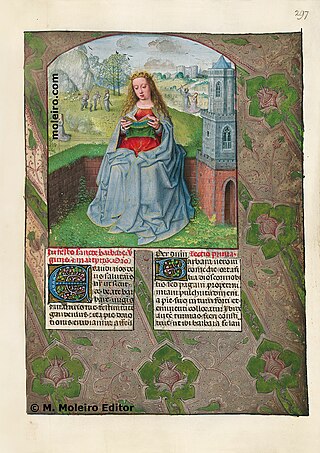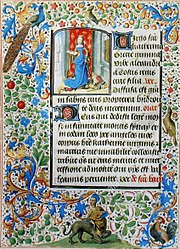
Jan van Eyck was a painter active in Bruges who was one of the early innovators of what became known as Early Netherlandish painting, and one of the most significant representatives of Early Northern Renaissance art. According to Vasari and other art historians including Ernst Gombrich, he invented oil painting, though most now regard that claim as an oversimplification.

The Froissart of Louis of Gruuthuse is a heavily illustrated deluxe illuminated manuscript in four volumes, containing a French text of Froissart's Chronicles, written and illuminated in the first half of the 1470s in Bruges, Flanders, in modern Belgium. The text of Froissart's Chronicles is preserved in more than 150 manuscript copies. This is one of the most lavishly illuminated examples, commissioned by Louis of Gruuthuse, a Flemish nobleman and bibliophile. Several leading Flemish illuminators worked on the miniatures.

Simon Bening was a Flemish miniaturist, generally regarded as the last major artist of the Netherlandish tradition.

Simon Marmion was a French and Burgundian Early Netherlandish painter of panels and illuminated manuscripts. Marmion lived and worked in what is now France but for most of his lifetime was part of the Duchy of Burgundy in the Southern Netherlands.

The Master of Anthony of Burgundy was a Flemish miniature painter active in Bruges between about 1460 and 1490, apparently running a large workshop, and producing some of the most sophisticated work of the final flowering of Flemish illumination. He was first identified by Winkler in 1921; his name is derived from one of his most elevated patrons, Anthony of Burgundy, Philip the Good's illegitimate son, though he also worked for the Dukes and other bibliophiles in Burgundian court circles, who had already been allocated "Masters" by art historians. His contributions to the heavily illustrated Froissart of Louis of Gruuthuse from the early 1470s, on which several of the leading illuminators of the day worked, show him excelling some more famous names, like Loiset Lyédet. The young Master of the Dresden Prayer Book worked as his assistant on this book, suggesting he was an apprentice; a number of other anonymous masters have been postulated as his pupils. Other works are in the libraries of Paris, Wrocław, Philadelphia, Munich, Cambridge University Library and elsewhere.

The Master of James IV of Scotland was a Flemish manuscript illuminator and painter most likely based in Ghent, or perhaps Bruges. Circumstantial evidence, including several larger panel paintings, indicates that he may be identical with Gerard Horenbout. He was the leading illuminator of the penultimate generation of Flemish illuminators. The painter's name is derived from a portrait of James IV of Scotland which, together with one of his Queen Margaret Tudor, is in the Prayer book of James IV and Queen Margaret, a book of hours commissioned by James and now in Vienna. He has been called one of the finest illuminators active in Flanders around 1500, and contributed to many lavish and important books besides directing an active studio of his own.

The Turin–Milan Hours is a partially destroyed illuminated manuscript, which despite its name is not strictly a book of hours. It is of exceptional quality and importance, with a very complicated history both during and after its production. It contains several miniatures of about 1420 attributed to an artist known as "Hand G" who was probably either Jan van Eyck, his brother Hubert van Eyck, or an artist very closely associated with them. About a decade or so later Barthélemy d'Eyck may have worked on some miniatures. Of the several portions of the book, that kept in Turin was destroyed in a fire in 1904, though black-and-white photographs exist.

The Isabella Breviary is a late 15th-century illuminated manuscript housed in the British Library, London. Queen Isabella I of Castile was given the manuscript shortly before 1497 by her ambassador Francisco de Rojas to commemorate the double marriage of her children and the children of Emperor Maximilian of Austria and Duchess Mary of Burgundy.

The Black Hours, MS M.493 is an illuminated book of hours completed in Bruges between 1460 and 1475. It consists of 121 pages (leaves), with Latin text written in Gothic minuscule script. The words are arranged in rows of fourteen lines and follow the Roman version of the texts. The lettering is inscribed in silver and gold and placed within borders ornamented with flowers, foliage and grotesques, on pages dyed a deep blueish black. It contains fourteen full-page miniatures and opens with the months of the liturgical calendar, followed by the Hours of the Virgin, and ends with the Office of the Dead.

Jean Wauquelin presenting his 'Chroniques de Hainaut' to Philip the Good is a presentation miniature believed to have been painted by the Flemish artist Rogier van der Weyden. It decorates the frontispiece to the Chroniques de Hainaut, MS KBR.9242, Jean Wauquelin's French translation of a three-volume history of the County of Hainaut originally written in Latin by the 14th-century Franciscan historian Jacques de Guyse.

The Hours of Joanna I of Castile is a sixteenth-century illuminated codex housed in the British Library, London, under call number Add MS 35313.

Lieven van Lathem (1430–1493), was an Early Netherlandish painter and manuscript illuminator.

The Book of Hours of Simon de Varie is a French illuminated manuscript book of hours commissioned by the court official Simon de Varie, with miniatures attributed to at least four artists; hand A who may have been a workshop member of the Bedford Master, the anonymous illustrators known as the Master of Jean Rolin II, the Dunois Master and the French miniaturist Jean Fouquet. It was completed in 1455 and consists of 49 large miniatures and dozens of decorative vignettes and painted initials, which total over 80 decorations. Fouquet is known to have contributed six full leaf illuminations, including a masterwork Donor and Virgin diptych. A number of saints appear - Saint Simon is placed as usual alongside Saint Jude ; other pages feature saints Bernard of Menthon, James the Greater and Guillaume de Bourges.

A presentation miniature or dedication miniature is a miniature painting often found in illuminated manuscripts, in which the patron or donor is presented with a book, normally to be interpreted as the book containing the miniature itself. The miniature is thus symbolic, and presumably represents an event in the future. Usually it is found at the start of the volume, as a frontispiece before the main text, but may also be placed at the end, as in the Vivian Bible, or at the start of a particular text in a collection.

The Master of Mary of Burgundy was a Flemish illuminator, painter and draughtsman active between 1469-1483 in Flanders, probably in Ghent. His notname is derived from two books of hours attributed to him, the Vienna Hours of Mary of Burgundy and another books of hours, now in Berlin, also for Mary of Burgundy.

Nicolas Spierinc was a Flemish illuminator and scribe active in late 1400s. Works attributed to him include the lettering of the Hours of Mary of Burgundy. He was a student of medicine at the University at Louvain, later changing his profession to a scribe and illuminator, moving to Ghent, where he found success and wealth. He is known to have collaborated with both Lieven van Lathem and the Master of Mary of Burgundy on prayer books of hours.
Antoine Philippe De Schryver (1924–2005) was a Belgian art historian and professor at the University of Ghent, where he lectured on History of Book Illumination. He was specialized in the field of illuminated manuscripts in the Southern Netherlands, 15th century painting, and artists at the Burgundian Court.

The Spinola Book of Hours is a sixteenth-century illuminated manuscript, consisting of 310 folios with 84 fully illustrated miniature paintings. This medieval manuscript was produced in the region between Bruges and Ghent in Flanders around 1510-1520. According to Thomas Kren, a former curator of the J. Paul Getty Museum, the artwork within the Spinola Hours can be attributed to five distinct artists. Forty-seven of these illuminated pages can be accredited to the 'Master of James IV'. The Spinola Hours bears a central coat-of-arms on the cover indicating it belonged to the Spinola family of Genoa. Today it is located at the J. Paul Getty Museum in Los Angeles.

The Master of Margaret of York is the Notname of an illuminator active in Bruges between 1470 and 1480. He owes his name to a devotional book he decorated for Margaret of York, wife of Charles the Bold, Duke of Burgundy. A large number of his illuminated books were executed for Louis de Gruuthuse. Several manuscripts have also been attributed to his assistants.

The Master of the Jardin de vertueuse consolation is the Notname of an illuminator active in Bruges in the years 1450 to 1475. He owes his name to a work by Pierre d'Ailly of which the decoration has been attributed to him, Le Jardin de vertueuse consolation, executed for Louis de Gruuthuse and today preserved in the Bibliothèque nationale de France as ms. fr. 1026.



























